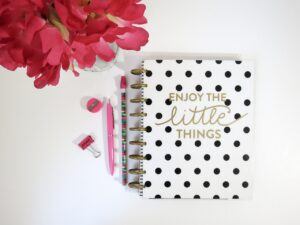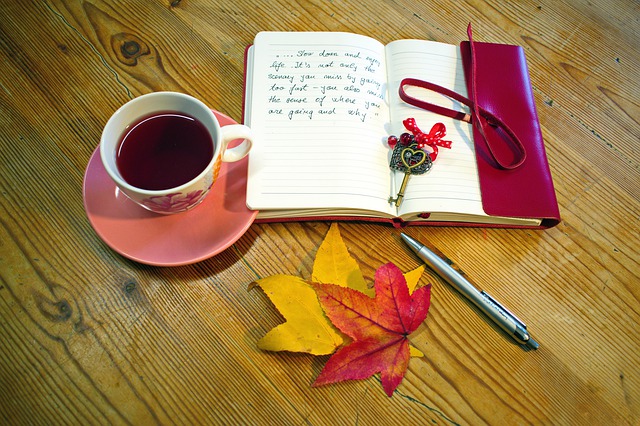Journaling is a great way to get in touch with thoughts and feelings, process, and release them. It is a much better way to cope with uncomfortable feelings than to keep them bottled up. Writing out our thoughts can be very  therapeutic and it is also a great way to record and track change. Often changes are subtle and we don’t recognize that we are growing but if you reread old journal entries you can see that progress is being made.
therapeutic and it is also a great way to record and track change. Often changes are subtle and we don’t recognize that we are growing but if you reread old journal entries you can see that progress is being made.
I am a believer in jornaling and always encourage my clients to use a journal to sort out thoughts and ideas, write out goals and track success. The ways to use a journal are really as endless as your creativity. I am going to give you a few ideas on how to use a journal that I feel are especially useful for people in the process of change.
A Reflection Journal
Often when someone is in a place of transition they feel overwhelmed. It can be difficult to actually articulate what you are thinking, truely want, what the next steps are, and on and on. This is the perfect time to just sit and write and see what comes out. You can absolutely just free flow, or write out bullet points. I am a fan of long hand, actually putting pen to paper, but I know some people really would rather do it on their phone or in a word document on their computer. Do what ever works for you so you will stay with it.
The idea with a reflection journal is just to see what comes out as you start writing. If you are having trouble starting you can also put a heading at the top of the page such as
- What do I want?
- How Do I feel about _________?
- Where do I want to be in 30 days?
- What would be the best possible outcome?
- Where do I have some power in this situation?
And just let it come out.
Gratitude Journal
A gratitude journal can help keep us in the present moment. When we are worried about staying on the path of recovery, it is easy to get lost in a place of fear and worry. Or, on what we might be missing out on, how are we going to cope, all of that stops you from being here in the now where some things might be going okay.
A great way to do a gratitude journal is to write out 3 things that you are  grateful for first thing in the morning or last thing at night. Every day add 3 new things, Easy right, well what you will find is that you need to start to get a little creative about 2 weeks in. This is where you start to look at things like I am grateful for my thumbs, or I am grateful for eyebrows. There are so many things that we take for granted. As the pages of your gratitude journal start to fill up you begin to realize that maybe things aren’t so bad. It’s a good idea to sit and read your lists from time to time, not just write them out but really sit with all that you have to be grateful for, it’s hard to sit in a place of self-pity when you have multiple pages of things to be grateful for sitting in front of you.
grateful for first thing in the morning or last thing at night. Every day add 3 new things, Easy right, well what you will find is that you need to start to get a little creative about 2 weeks in. This is where you start to look at things like I am grateful for my thumbs, or I am grateful for eyebrows. There are so many things that we take for granted. As the pages of your gratitude journal start to fill up you begin to realize that maybe things aren’t so bad. It’s a good idea to sit and read your lists from time to time, not just write them out but really sit with all that you have to be grateful for, it’s hard to sit in a place of self-pity when you have multiple pages of things to be grateful for sitting in front of you.
Build Self-Esteem With The Daily Success Journal
Going through recovery it’s easy to focus on all the things that you have done that you are not happy about. Painful emotions such as shame, sadness, loss, and guilt often start to bubble up to the surface as our head clears up. The self-esteem takes a real hit. Or it could be that low self-esteem fueled the use of the substance or behavior you were using and now you have to face yourelf and don’t like what you see. Whichever place you find yourself in, before bed  each night take the time to reflect over the events of the day and write out 3 things that went well. Or better yet, carry a small notebook with you and write things down as they happen. It is a great way to start to build yourself back up again. They can be big things like, I got a raise, or just simple things like a random act of kindness, or even I had a really strong urge to use today and used some of my tools instead of giving into it. You don’t have to stop at 3 things either.
each night take the time to reflect over the events of the day and write out 3 things that went well. Or better yet, carry a small notebook with you and write things down as they happen. It is a great way to start to build yourself back up again. They can be big things like, I got a raise, or just simple things like a random act of kindness, or even I had a really strong urge to use today and used some of my tools instead of giving into it. You don’t have to stop at 3 things either.
About a week to 10 days in, you will notice that you are more aware of the good things happening because your brain is on the lookout for successes to write in your journal at the end of the day. And as with the gratitude journal, once the entries start to add up and you look back over pages and pages of good things happening in your life you may just start to beleive that you are good enough.
You can also use this journal to make a list of past successes. Take some time to look back over your life and identify things that you have done that you are proud of and felt a sense of accomplishment around. Graduating from high school, buying a home, riding a bike. Can be big or little as long as you felt good about it.
Daily Goals/Tasks Journal
I got this idea from a T Harv Eker training where you had a set of daily tasks to complete. I think it is a great idea to have a daily checklist of things that are an important part of your recovery program. For Example, you can include things like:
Daily Affirmations – either have a list you read daily or write out one of your favorite ones and repeat it over and over.
Daily Tapping Exercises – tap on triggers, hurt feelings, have a list and tap daily for 5 minutes (EFT – more on this later)
Read Recovery or Inspirational Literature – Schedule in time for reading or listening to inspirational messages.
Meditation/Mindfulness Practice – Time to stop and be still.
Self Care Today – (Write out several things you did for yourself today, could be went to the gym, went to a meeting, got an extra 30 minutes of sleep)
Journal Entry – Reasons to stay on my path of recovery or why I am grateful for today
Having a daily Recovery To Do list is a way to stay focused. Schedule in time for a weekly reflection on next steps or revisit reasons to stay the course. It’s also a great way to get back on track quickly if you slip. You can even use your journal time to analyze and come up with a plan to do something different next time. Be creative, find a way to make time for yourself.
At the same time it is also important to be mindful not to overwhelm yourself with too many daily tasks. Have one or two things you do daily, for instance meditation and journaling. The rest of the week pick one or two additional things so you build skills for success.
Example:
Monday:
- Meditation
- Journaling
- Affirmations
- Exercise
Tuesday:
- Meditation
- Journaling
- Tapping
- Read/Listen to Inspiration Stories
Wednesday
- Meditation
- Journaling
- Yoga
- Affirmations
Creative Visualization Journal
Remember that it is the vision of the future that we want and dream of, that continues to pull us forward when change gets tough. the idea with a creative visualization journal is to write out your future vision. You can write out what you want your life to look like 6 months from now, 1 year from now, 3 years, 5 years. As you write it out, put as much detail as you possibly can, be able to see the future in your mind when you close your eyes.
You can do one long narrative of what life looks like or you can break it down by areas of your life. What do your relationships look like, career, your home, finances, health, leisure activities, spiritual health, etc…
Revisit and read your entries often, continue to add to them. You can also draw pictures, or if you see a picture in a magazine or catalog you can add that to your journal, almost like creating a scrapbook or a vision board in your journal. Spend time really feeling what it will be like as you continue to create the life you want.
Conclusion
There is no right or wrong way to keep a journal. These are just a few ideas to get you started, I usually have a few journals going at the same time. I have one on hopes and dreams, I have the daily goals’ journal and then I have a  process journal. Pick out a journal that you find attractive, maybe get a new pen, set aside 20 to 30 minutes where you won’t be interrupted and see how it feels to start putting thoughts on paper.
process journal. Pick out a journal that you find attractive, maybe get a new pen, set aside 20 to 30 minutes where you won’t be interrupted and see how it feels to start putting thoughts on paper.
Let me know your success with journaling.
Here are a couple of options to find a journal and get started:
Peace and Joy on your Recovery Path!

